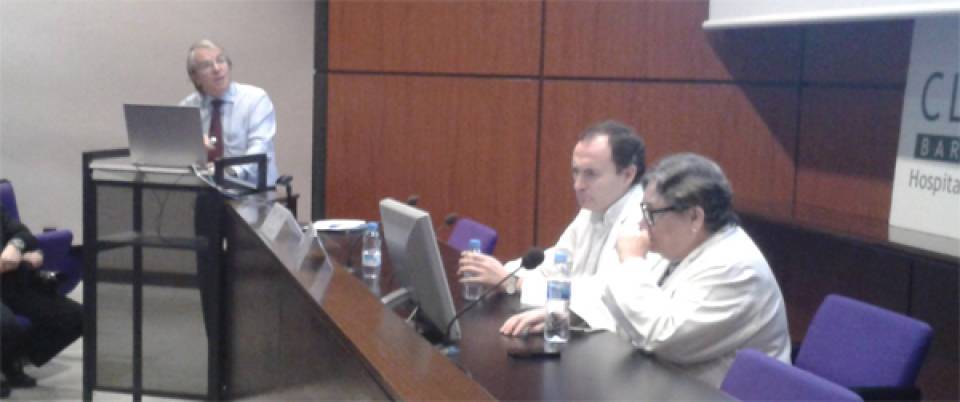These investigators pulsed patient's own dendritic cells (DCs) with heat-inactivated whole autologous HIV and then used these cells as a vaccine, obtaining the best virological response achieved by any therapeutic vaccine tested up to date. Dr. Felipe García, Dr. Montserrat Plana and Dr. Teresa Gallart are the main authors of this work performed within the frame of the HIVACAT Program for the research and development of a therapeutic and preventive vaccine candidates against AIDS. HIVACAT is an initiative that joins the efforts of IDIBAPS-Hospital Clínic and IrsiCaixa, together with Obra Social “la Caixa” and ESTEVE, as well as with the support from Health and Economy and Knowledge Ministries of the Catalan Government (Generalitat de Catalunya).
DCs are the “professional” antigen presenting cells. This means that when a microorganism invades the body, these cells phagocyte it (eat it) and break it into small fragments. Some of these fragments are presented in the membrane of DCs. During this process DCs maturate and migrate to lymph nodes. There, they attach to CD4+ lymphocytes (a special type of white blood cells) and present the pieces of the phagocytosed microorganism. The CD4 cells realize that the body has been invaded by an external agent and start a specific immune response against this particular intruder. The problem, in the particular case of the HIV infection, is that DCs can also carry viable infectious virus attached to their outer membrane. Consequently the CD4+ cells can get infected and die instead of developing an immune response. That is the reason why our vaccine candidate uses DCs primed with autologous heat inactivated HIV, so that DCs can adequately transmit the message without causing a productive lytic infection of the CD4+ cells.
For the study published in Science Translational Medicine, 36 patients on cART with CD4+ >450 cells/mm3 were randomized to receive three immunizations with pulsed DCs or with nonpulsed DCs. Vaccination was feasible, safe, and well tolerated and shifted the virus/host balance in favor of the host. At weeks 12 and 24 after cART interruption, a reduction of the predicted plasma viral load set point of more than 90% was observed in 12 of 22 (55%) versus 1 of 11 (9%) and in 7 of 20 (35%) versus 0 of 10 (0%) patients in the DC–HIV-1 (vaccinees) and DC-control groups, respectively. Most of the vaccine recipients had been able to temporarilly control viral replication with a peak reduction above viral load set point of 93%. This figure is similar to the response to antiretroviral medications when they are used as monotherapy. It is the strongest proof of concept in the scientific literature that a therapeutic vaccine is feasible.
This significant decrease in plasma viral load observed in immunized recipients was associated with a consistent increase in HIV-1–specific T cell responses. This means that the vaccine effectively stimulated the immune system. The study opens the path for additional studies with the final objective to reach a functional cure (the potential control of HIV replication without lifelong antiretroviral therapy). A patient with a functional cure would still be a virus carrier at undetectable levels, so preventive measures would still be necessary although transmission risk will be minimized. Although a functional cure has not yet been achieved, the results published today open the possibility that an optimized therapeutic vaccine, or a combination of strategies including a therapeutic vaccine, could contribute to achieve this goal according to the Editor´s summary* of the paper published in Science Translational Medicine.
About HIVACAT
HIVACAT is the Catalan project for the development of an effective vaccine against the HIV virus. The organization is a joint public and private sector consortium unprecedented in Spain, placing our country at the forefront of international research in this field. Composed of Catalonia’s two longest established and leading AIDS research centres, the AIDS and Infectious Diseases Service at Barcelona’s IDIBAPS-Hospital Clínic and the Institute for AIDS Research IrsiCaixa, HIVACAT conducts research into the development of a new HIV vaccine, in conjunction with the organization ESTEVE, and with the support of “la Caixa” Foundation, the autonomous Catalan government’s Department of Health and the Department of Economy and Knowledge plus the Clínic Foundation at Barcelona’s IDIBAPS-Hospital Clínic. This consortium is the first major collaboration attempt between local government, research centres and private enterprise in this field.
Both centres carry out research alongside their more than 5,000 patients, who benefit from the rapid incorporation of new treatments developed at the centres themselves, and from innovations achieved on an international scale. HIVACAT combines the clinical and scientific experience of more than 60 researchers trained in internationally respected research institutions, such as Harvard University in the USA, the Institut Pasteur in Paris and the Royal Free Hospital in London, who work in close collaboration on a diverse range of projects with prestigious international research groups.
HIVACAT will host the 2013 AIDS Vaccine Conference, the biggest and most prestigious international meeting focused on the research for the development of a vaccine for the HIV.
In this study there also participated: Dr. Brigitte Autran, Université Paris-VI Pierre-et-Marie-Curie, Hôpital Pitié-Salpêtrière, Paris; and Dr. Jeffrey D. Lifson, AIDS and Cancer Virus Program, SAIC-Fredrick Inc., Fredrick National Laboratory for Cancer Research, USA.

